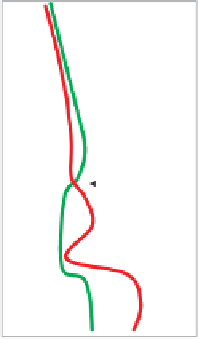Geology Reference
In-Depth Information
example where pore characteristics are intimately
associated with depth independent diagenetic pro-
cesses. The following discussion will focus on siliclas-
tic (sand/shale) lithologies.
Sands and shales are originally deposited as sus-
pensions but become load bearing rocks upon burial.
The depositional or
500
Mechanical
compaction
dominates
Sand/shale
V
p
crossover
1000
porosity (i.e. the point at
which there is no cohesion between grains) varies
significantly between 36%
'
critical
'
1500
-
80% porosity in shales. Shales tend to de-water rapidly
and, providing that it is possible for expelled water to
escape to surface, generally follow an exponential
decrease in porosity with increasing depth. Athy
(
1930
) defined the relationship:
ϕ
¼
ϕ
0
e
cz
,
-
40% for sands to 60%
Sand
Onset of
cementation
2000
Chemical
compaction
dominates
Shale
2500
1
2
3
4
V
p
where
ϕ
0
is the critical porosity, c is a constant and
Figure 5.8
Generalised velocity-depth trends for sands and shales
in the Palaeogene offshore Norway (modified after Avseth,
2000
).
z
depth.
Similar functions have been derived from different
basins (e.g. Ramm and Bjorlykke,
1994
; Dutta et al.,
2009
). Clean sands generally have a more linear
relationship of porosity decrease with increasing
depth. Mechanical compaction, characterised by grain
rearrangement and crushing in sands and collapse of
platy mineral structures in shales, is the dominant
mechanism in the upper part of the section. These
processes reduce porosity and stiffen the rock, increas-
ing acoustic impedance and decreasing Poisson
¼
Thus for the shallow zone, a shale
sand interface is
marked by a negative AI change and a modest nega-
tive PR change, giving rise to a negative zero offset
reflection coefficient and a modestly negative AVO
gradient (i.e. a Class III AVO response). For the deep
zone,
-
sand interface has a positive AI
change and a more marked negative PR change than
the shallow section, giving a positive zero offset reflec-
tion coefficient and a markedly negative AVO gradi-
ent (i.e. a Class I response). Class II and IIp responses
will be found in the vicinity of the cross-over.
The schematic trends shown in
Fig. 5.9
are seldom
quite so clear in real data. Impedance crossovers may
occur within a fairly restricted depth range or they
may be an extensive zone hundreds of metres thick.
Indeed there may be more than one crossover.
Sedimentology and pressure variations are key factors
in modifying the trends. For example, the presence of
silts and carbonates (and other lithologies such as
volcanic tuffs) can dramatically modify the imped-
ance contrasts. Clearly, it is particularly important
when analysing numerous wells for rock physics
trends that detailed rock characterisation is done
before averaging the data (e.g. Avseth et al.,
2008
).
the shale
-
s ratio.
Mechanical compaction gives way to chemical com-
paction largely through the influence of temperature.
Generally at around 70
'
80°C smectite transforms to
illite (which is harder than smectite) with the produc-
tion of both water and silica. This change in the nature
of shale is often observed to be associated with the
onset of cementation of sands (Avseth et al.,
2008
).
Figure 5.8
shows an example of relative changes in
compressional velocity between sands and shales
related to both mechanical and chemical compaction.
Figure 5.9
shows schematic illustrations of several
effects of compaction on clean sands and shales. Typ-
ically in the shallow parts of basins shales have higher
AI than the sands, whereas in the deeper (more com-
pacted) section the sands have higher AI than shales.
Thus, at a certain depth the sand and shale impedance
trends cross-over, with very low AI contrast between
them. Above this depth, shales are harder than sands
(
Fig. 5.9a
) and generally have a slightly higher Pois-
son
-
5.3.3 The effect of fluid fill
In general, the effect of replacing brine with
hydrocarbon is to reduce the P wave velocity and
the density of the rock, whilst having little effect on
the shear velocity (see
Chapter 8
). The bulk modulus
s ratio than sands. Below the cross-over, the sands
are harder than the shales and the high AI (low
porosity) sands start to have markedly low PR values.
'
63

















